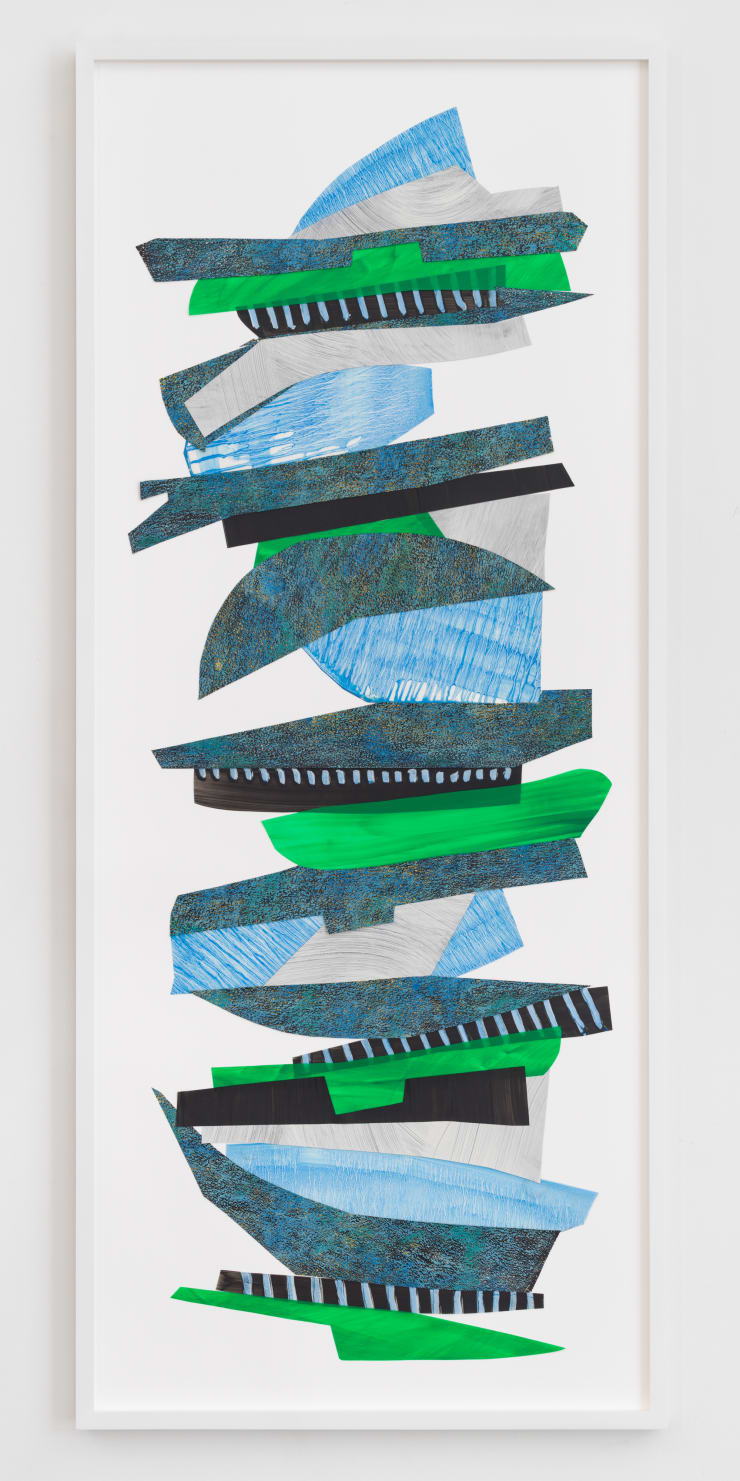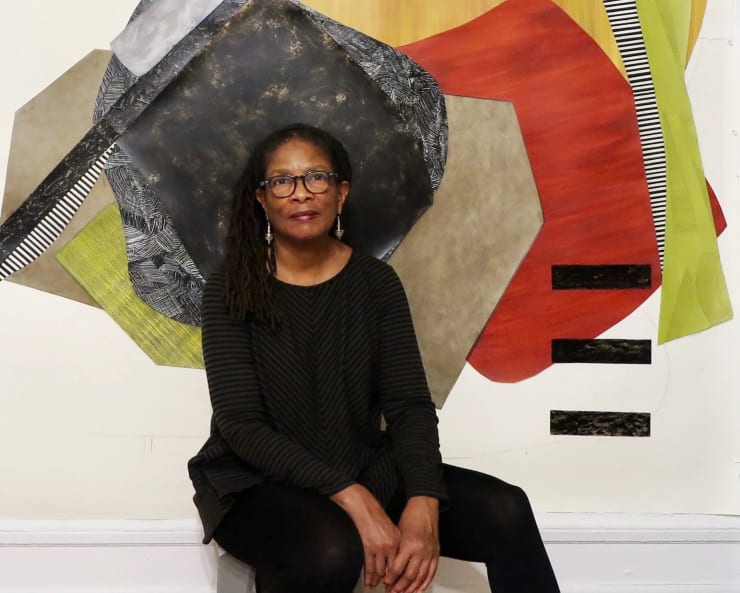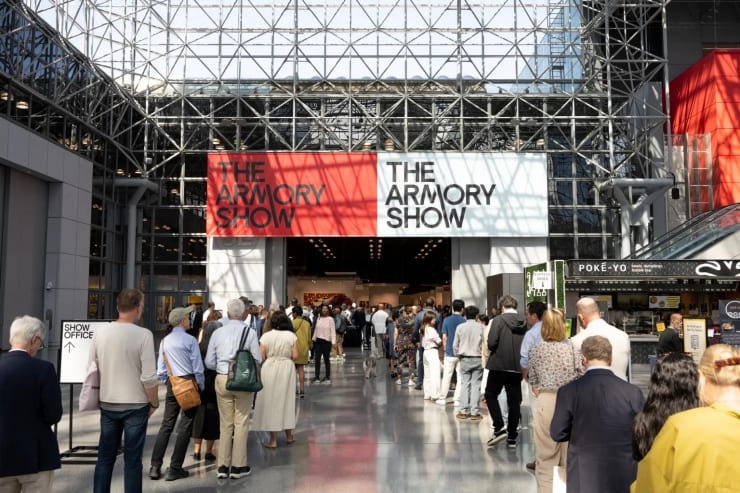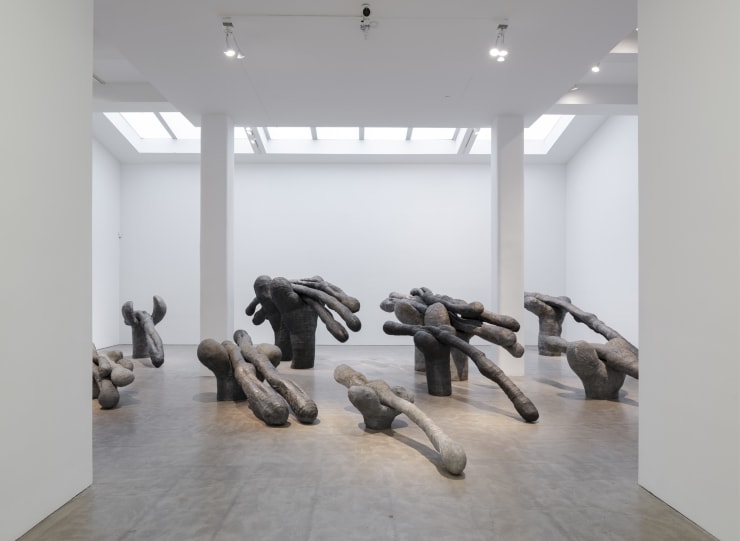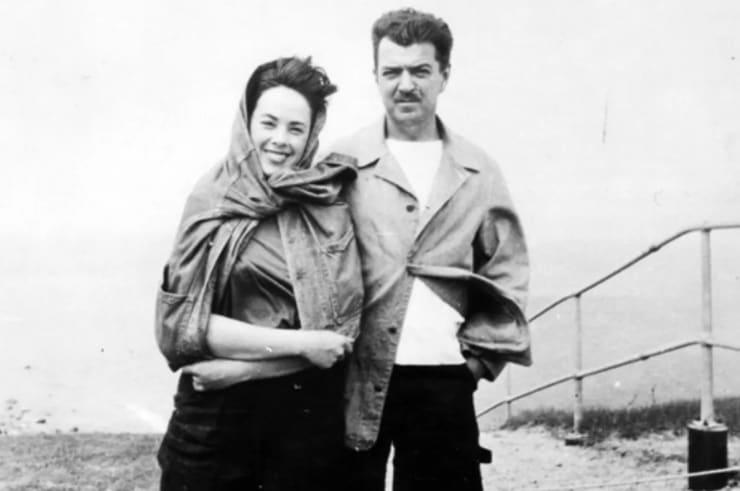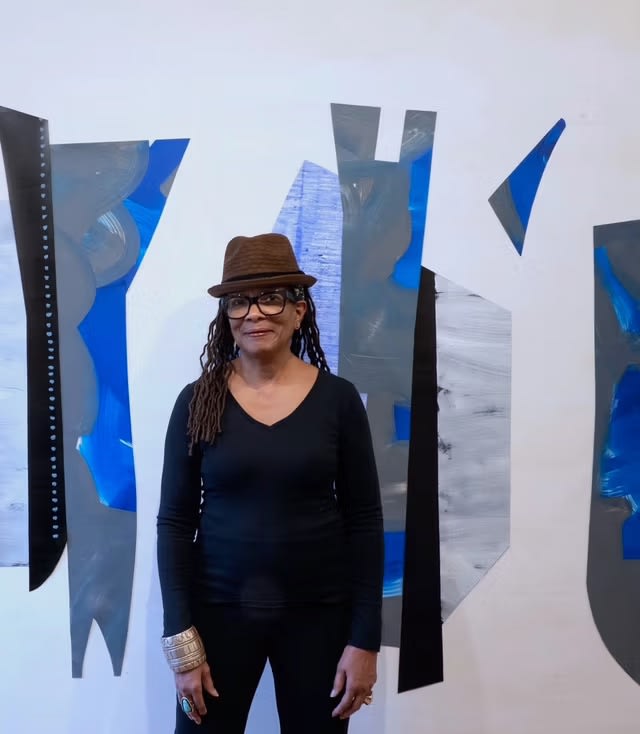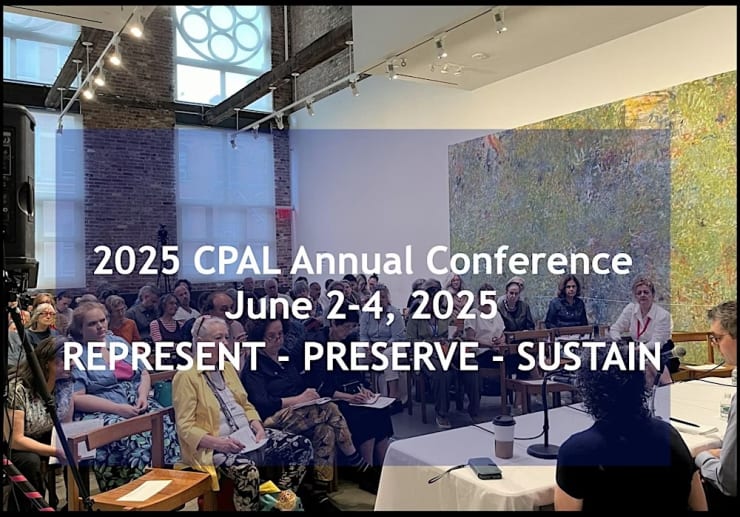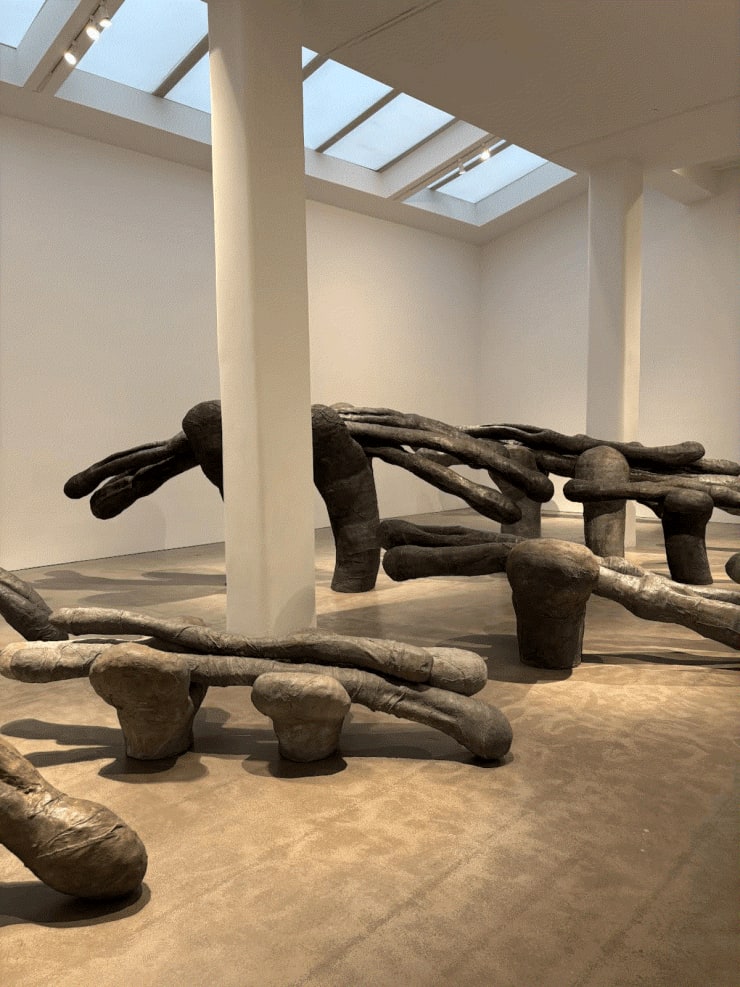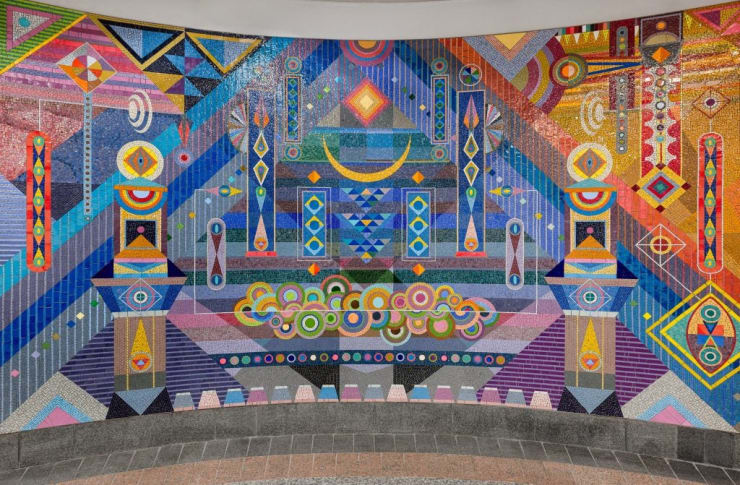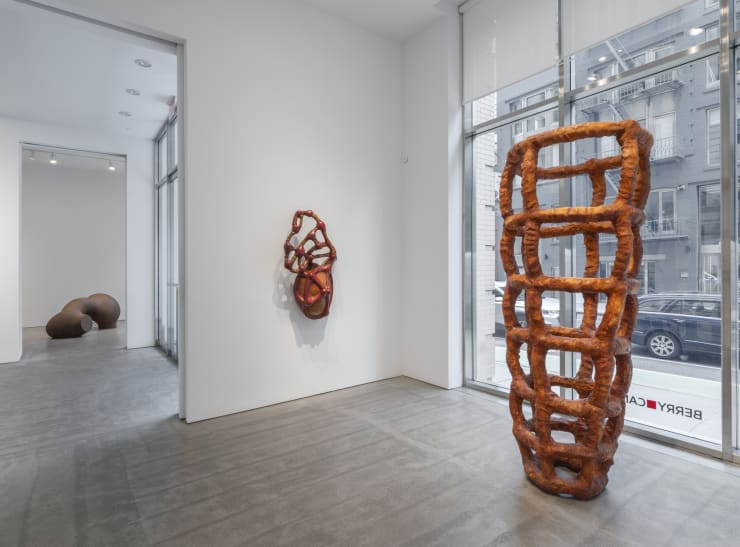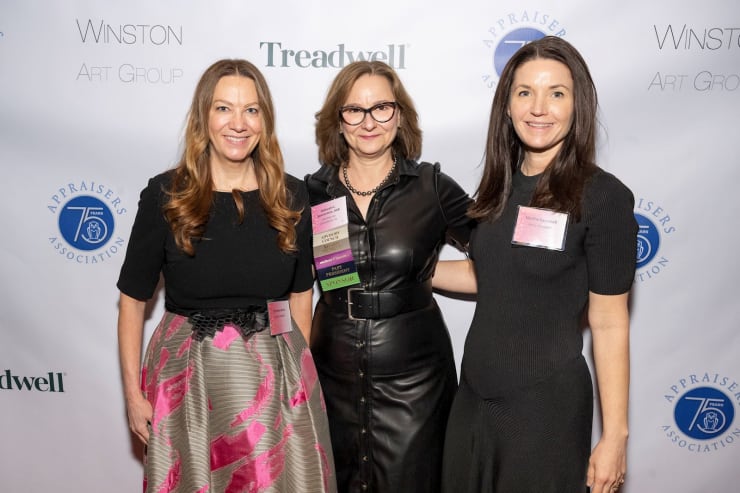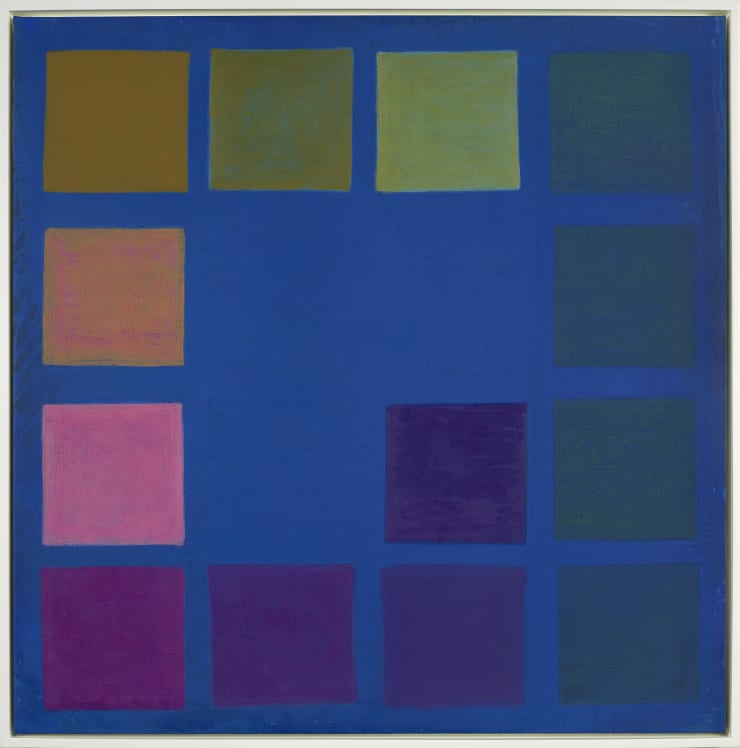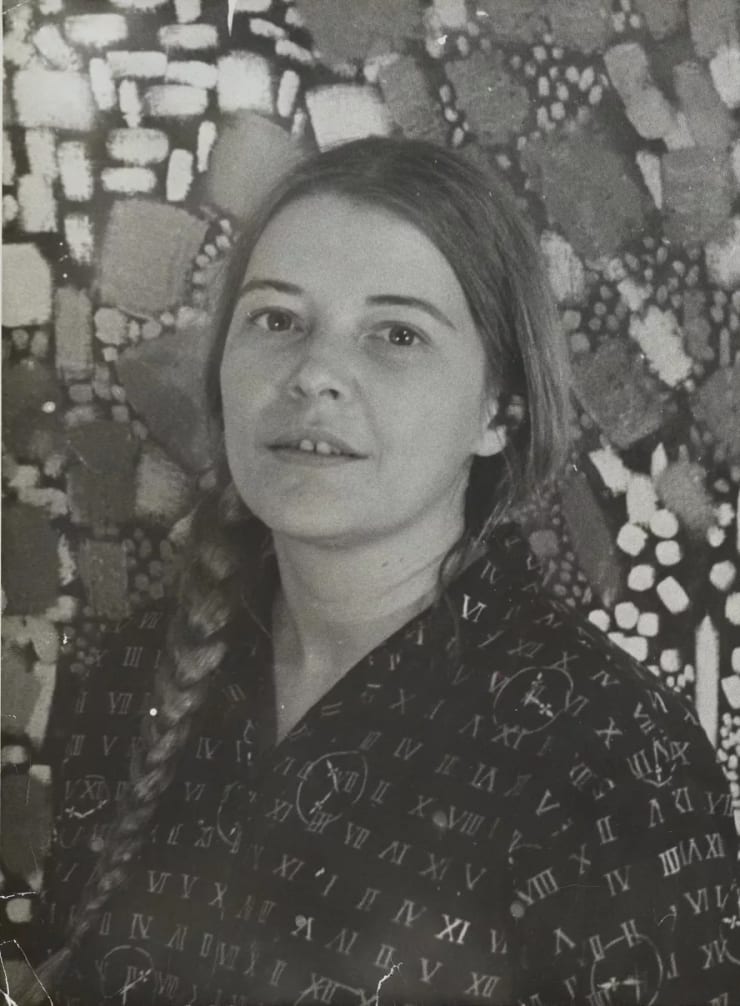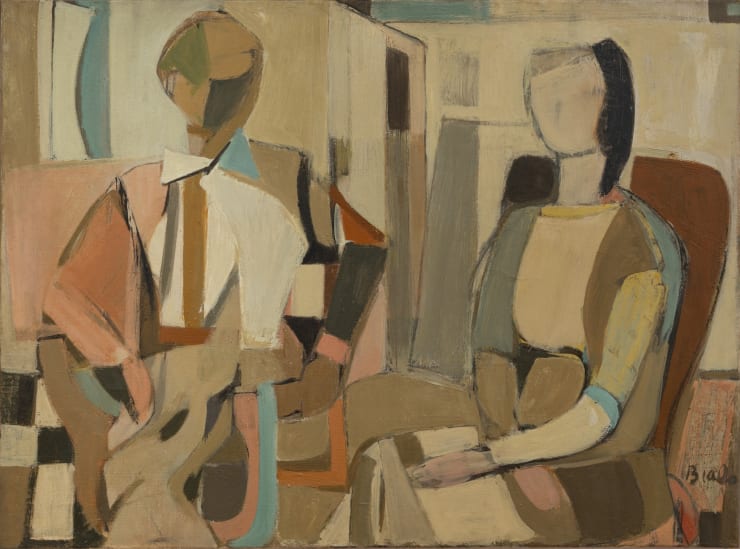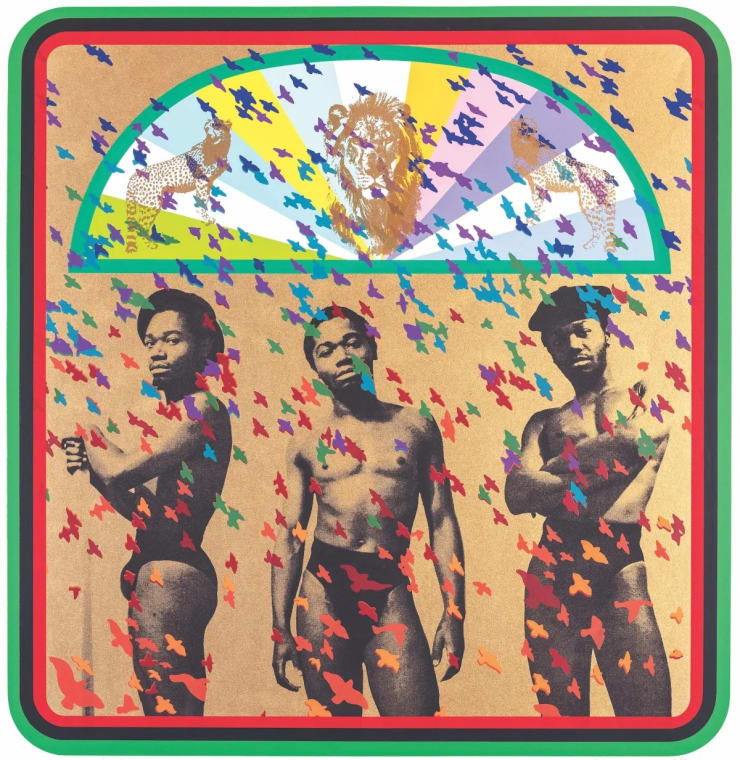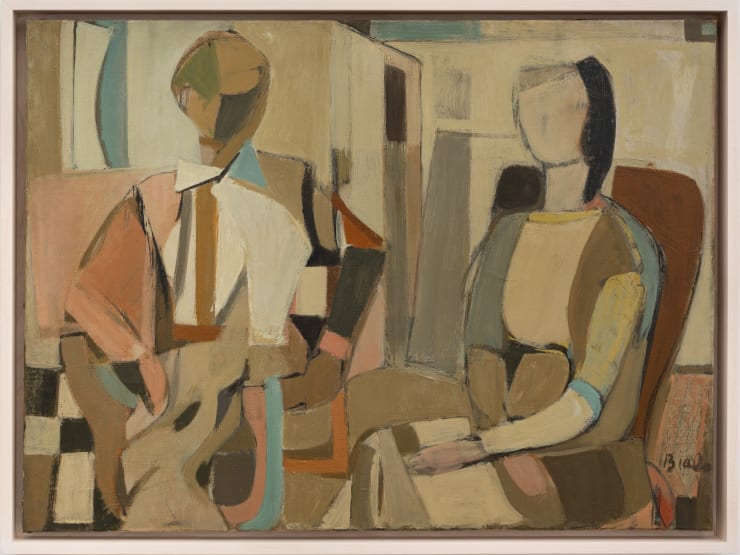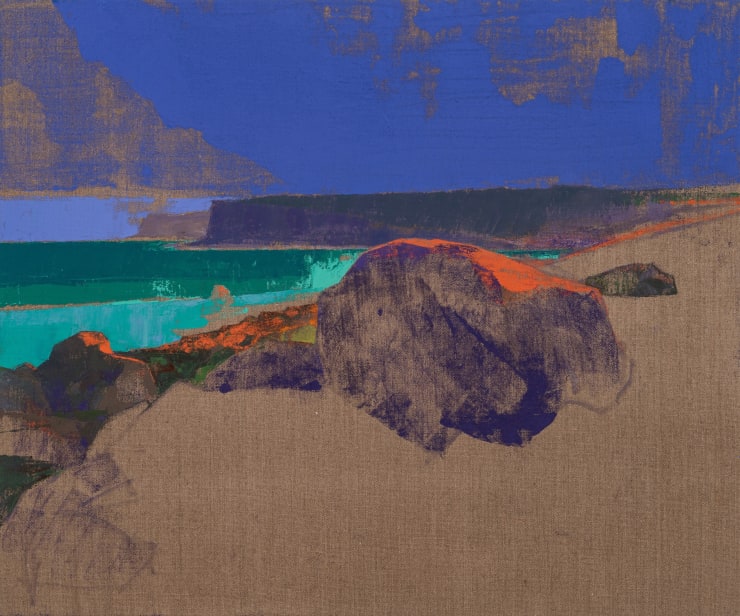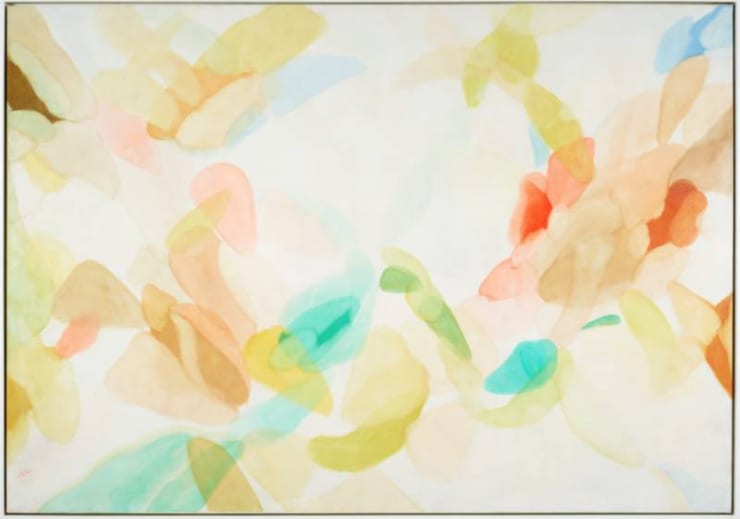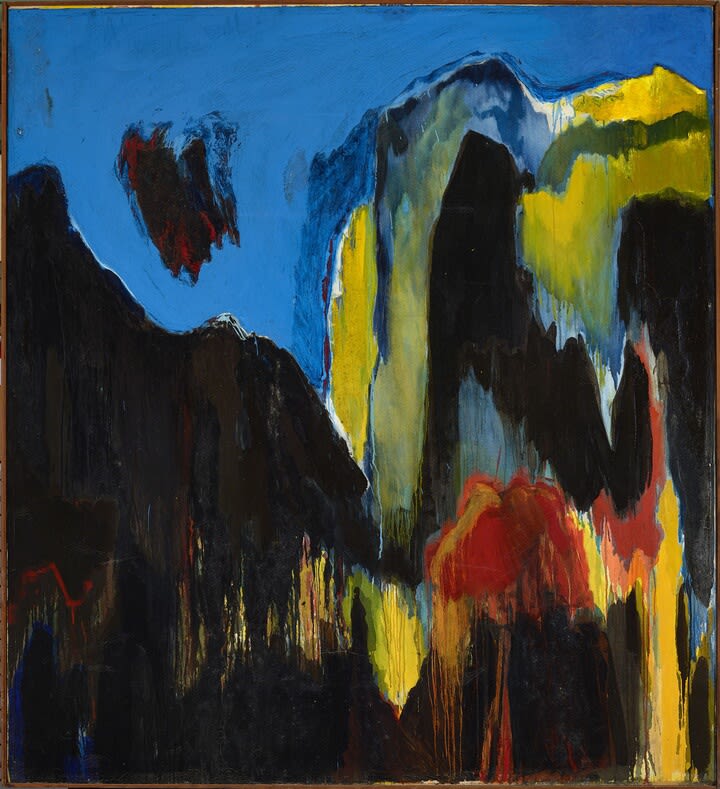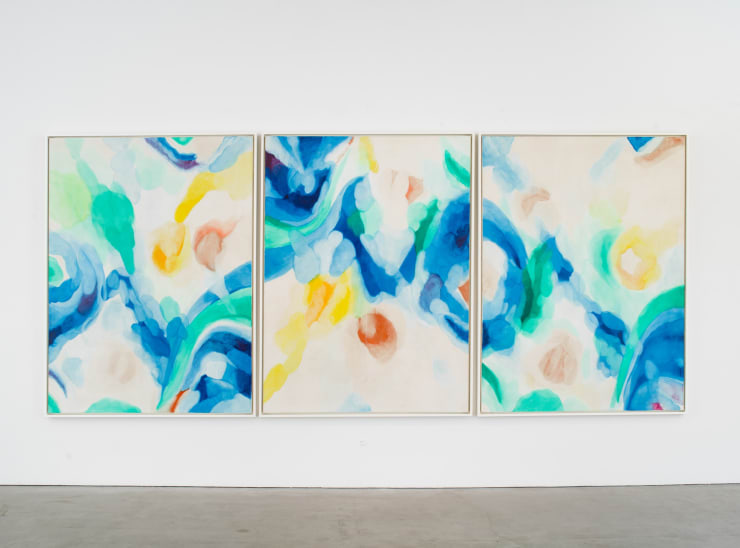-

HERE & THERE
Nanette Carter at The Church Sag Harbor October 4, 2025 HERE & THERE The First Churchennial October 05 - December 29, 2025 Opening Reception: Saturday, October 4th, 6 PM -... Read more -

James Walsh: Relief in Sight
The Sam and Adele Golden Gallery September 27, 2025 James Walsh: Relief in Sight: Selected paintings from 1981 through 2025 September 27, 2025 – February 20, 2026 The Sam... Read more -

Charlotte and Jim: A Personal Reminiscence – Artist Mike Solomon in Conversation with Christine Berry
The Leiber Collection September 21, 2025 The Leiber Collection Sunday, September 21st at 4:00 pm 446 Old Stone Highway, East Hampton, NY East Hampton, New York:... Read more -

Nanette Carter Is a Pioneer of Black Abstraction—and She’s Still Experimenting Today
Artsy September 18, 2025 When she was in high school, Nanette Carter walked into the Guggenheim on a field trip to see the 1971... Read more
-

Beverly McIver On View | We Belong Here: The Gutierrez Collection
Cameron Art Museum April 25 – September 7, 2025 We Belong Here: The Gutierrez Collection Cameron Art Museum April 25, 2025 – September 7, 2025 We Belong Here: The... Read more -

A Brisk Start to the Armory Show Suggests Optimism as the Market Adapts to New Rhythms
The Observer September 5, 2025 Opening day sales point to confidence returning, even as galleries are recalibrating their strategies to align with changing buyer expectations.... Read more -

Jill Nathanson | Instructor Salon 2025
Art Students League September 3, 2025 Opening Reception: Wednesday, September 3, 6–8 PM A tradition that’s more than a century old; the Art Students League... Read more -

12 Must-See Gallery Shows in New York This Fall
Artnet September 2, 2025 From art historical rediscoveries to emerging upstarts, here are some of the standout gallery shows on our radar. The summer... Read more
-

Mary Ann Unger
Artforum September 2, 2025 Mary Ann Unger (1945–1998) was a New York–based sculptor possessed of formidable technical skill and creative vision. She drew upon... Read more -

A Sense of Place
The East Hampton Star August 31, 2025 “Charlotte Park and James Brooks—Of This Place,” an exhibition exploring the connection between two of the East End’s celebrated artists... Read more -

Beverly McIver On View
Bobbitt Visual Arts Center | Albion College August 30, 2025 Beverly McIver Munro Gallery | Bobbitt Visual Arts Center | Albion College August 30 - September 27, 2025 Reception: 5-7pm... Read more -

From Miami to Manhattan: Must-See Exhibitions, Galleries, and Events at Armory Week 2025 Aug 28
Miami Living August 28, 2025 As art lovers from Miami and beyond head north to New York for one of the biggest moments in the... Read more
-

ABSTRACT EXPRESSIONISTS: THE WOMEN
Female Artists of the Mougins Museum & American Federation of Arts August 23, 2025 FAMM (Female Artists of the Mougins Museum), the only private museum in the world outside the United States with a... Read more -

'Abstract art is universal': Nanette Carter on her new career survey at the Wexner Center for the Arts
The Art Newspaper August 8, 2025 The artist speaks about what drives her practice in anticipation of a solo exhibition in her hometown of Columbus, Ohio,... Read more -

Eric Dever: To see through the garden | ISSUE 67 — SUMMER 2025
Antennae | Journal ISSUE 67 — SUMMER 2025 Rooted in personal experience and ecological observation, this reflection traces the evolving relationship between painting and gardening in the artist’s... Read more -

Charlotte Park and James Brooks: Of This Place
Leiber Collection August 2, 2025 Charlotte Park and James Brooks: Of This Place August 2 to October 5, 2025 Opening Celebration: Saturday, August 2, from... Read more
-

Chelsea Exhibition Reviews: New York Society of Women Artists, Berry Campbell, Rosebud Contemporary and GoCA
Whitehot Magazine August 1, 2025 From my perspective, a great on-site introduction to an artist comes when stepping into a solo show that really sweeps... Read more -

Interview | Nanette Carter by Matthew Deleget: Finding the tools and materials.
BOMB July 30, 2025 In the summer of 2019, my family and I moved to South Orange, New Jersey, after twenty-five years of living... Read more -

Nanette Carter On View | Material Girl
Athens Cultural Center July 20, 2025 Athen Cultural Center On View June 6 - July 20, 2025 Gallery Hours: Saturdays & Sundays 12-5pm First Friday Reception... Read more -

ADAA Chelsea Gallery Walk & Artist-Led Exhibition Tour
Art Dealers Association of America July 16, 2025 Wednesday, July 16, 2025, 6 - 8 pm 524 W 26th Street, New York Please join us Wednesday, July 16th... Read more
-

The Artsy Edit | Rising stars, overlooked greats, and Foundations 2025
Artsy July 16, 2025 Hi and welcome back to The Artsy Edit, a quick guide to what’s happening in the art world this week.... Read more -

Decades Ago, Painter Syd Solomon’s Phillippi Creek Home Became a Magical Gathering Spot for an Endless Stream of Famous Artists
Sarasota Magazine July 10, 2025 Imagine growing up along the shores of Sarasota’s Phillippi Creek , back in the more bucolic 1950s and ’60s, in... Read more -

Rescatan la figura de Lucia Wilcox, la artista que introdujo el surrealismo en EEUU
El Grito | El Confidencial July 10, 2025 Afincada en Nueva York tras la amenaza y los ecos de guerra en Europa, la artista introdujo el movimiento surrealista... Read more -

Eric Dever returns with a new botanical series on view in New York
The Flora Journal July 3, 2025 Berry Campbell Gallery , located in Chelsea, New York, USA, presents Eric Dever: Points of Interest , an inspiring new... Read more
-

Event | In Conversation with Nanette Carter
Montclair Art Museum June 25, 2025 In Conversation with Nanette Carter June 25, 2025 7:00 pm - 8:00 pm Join Ben Jones and artist Nanette Carter... Read more -

She Brought Surrealism to America—and Painted Her Own Myth. How Was She Forgotten by History?
Artnet June 20, 2025 Lucia Wilcox rubbed shoulders with Surrealists in Paris, reinvented herself in New York, and created fantastical scenes of jubilant women.... Read more -

Beverly McIver | Exhibition | Kinetic Traces
National Academy of Design June 12, 2025 Kinetic Traces Location: National Academy of Design, 519 W 26th St, Floor Two New York, NY 10001 Date: June 12,... Read more -

2025 CPAL Annual Conference
Center for the Preservation of Artists' Legacies June 4, 2025 2025 CPAL Conference June 2 – June 4, 2025 Location - The Milton Resnick and Pat Passlof Foundation 87 Eldridge... Read more
-

Artfully Investing: An Art Market Update and Private Planning Discussion
HSBC Event June 4, 2025 HSBC Private Banking Hosts “Artfully Investing: An Art Market Update and Private Planning Discussion” at the renowned Berry Campbell Gallery... Read more -

Ready for Their Reboot: How Galleries Plumb Art History’s Forgotten Talent
The New York Times June 4, 2025 Call it the ‘‘rediscovery industrial complex”: Art advisers and dealers are turning to the past to discover tomorrow’s blue-chip stars.... Read more -

Nanette Carter: Recent Work
The John Hopkins Review | Volume 18, Spring 2025 Spring 2025 'Nanette Carter makes eloquent, inventive collages, ambiguous meditations on her heritage as a Black American and the history of modernism.... Read more -

Chelsea Exhibition Reviews: Rosebud Contemporary, Paula Cooper, Fredericks & Freiser, Berry Campbell and more
Whitehot Magazine May 29, 2025 Mary Ann Unger: Across the Bering Strait at Berry Campbell (April 17 - May 17, 2025) Monumental sculpture exhibitions are... Read more
-

Nanette Carter Returns Home to Montclair With New Solo Exhibition
All of It with Allison Stewart | WNYC May 28, 2025 Nanette Carter in Conversation with Allison Stewart All of It | WNYC May 28, 2025 Artist Nanette Carter grew up... Read more -

In The Gallery: How Berry Campbell Gallery Champions Under the Radar Artists
Whitewall May 27, 2025 Founded by Christine Berry and Martha Campbell, the New York-based gallery is redefining curatorial excellence through scholarship-driven exhibitions, a commitment... Read more -

Artforum Must See | Mary Ann Unger
Artforum Artguide May 17, 2025 Must See Mary Ann Unger Mary Ann Unger: Across the Bering Strait April 17 - May 17, 2025 Reception: Thursday,... Read more -

Hilma’s Ghost Haunts New York’s Grand Central Station With a Dazzling Mosaic
Artnet May 16, 2025 Their big MTA unveiling came during Frieze Week, and I saw Tegeder and Ray later that night, at a feminist... Read more
-

ARTSEEN | Mary Ann Unger: Across the Bering Strait
The Brooklyn Rail May 14, 2025 Coinciding with New York City’s spring art fairs, Berry Campbell Gallery is presenting a thorough and impressive mini-retrospective of Mary... Read more -

Pamela Thomas-Graham in Conversation with Christine Berry on Collecting
NADA New York May 10, 2025 May 10, 2025, 4pm Pamela Thomas-Graham in Conversation with Christine Berry on Collecting NADA New York 601 W 26th Street,... Read more -

A Late Feminist Sculptor Who Plumbed the History of Human Migration
Hyperallergic May 9, 2025 Mary Ann Unger’s massive biomorphic artworks, now on view in New York City, are shockingly prescient and powerful now more... Read more -

Ahead Of Mother’s Day, Artist Eve Biddle Recounts Growing Up Among The Monumental Oeuvre Of Her Own Mom, Mary Ann Unger
May 9, 2025 When Mary Ann Unger’s Across the Bering Strait debuted in 1994, the sprawling, 34-part installation's raw tactile surfaces and forward... Read more
-

Collecting in the Contemporary Art World: A Conversation with Berry Campbell Gallery, NYC
Arkansas Museum of Fine Arts May 8, 2025 Christine Berry, Co-Founder of Berry Campbell Gallery in New York City, will share her perspective on the contemporary art world... Read more -
 Museum Acquisition | Ann Purcell at Femmes Artistes du Musée de Mougins May 7, 2025 Ann Purcell (b. 1941) Gypsy Wind , 1983 Acrylic and collage on canvas 72 x 60 inches (182.9 x 152.4... Read more
Museum Acquisition | Ann Purcell at Femmes Artistes du Musée de Mougins May 7, 2025 Ann Purcell (b. 1941) Gypsy Wind , 1983 Acrylic and collage on canvas 72 x 60 inches (182.9 x 152.4... Read more -

18 Essential Spring Exhibitions to See in New York
Artnet May 5, 2025 As Frieze approaches, New York exhibitions abound—spotlighting major names from Picasso and Leonor Fini to Salman Toor and Rashid Johnson.... Read more -

Nanette Carter’s Abstract Balancing Act
Hyperallergic May 5, 2025 In this retrospective, the Montclair-raised artist gives the viewer a look at an artistic language that continues to evolve and... Read more
-

MOCRA Presents "Meditations" on Art, Abstraction, and Spirituality
Saint Louis University's Museum of Contemporary Religious Art May 3, 2025 “Meditations” explores the intersection of spirituality and the artistic practice of Black creatives encountering ideas within the wide lexicon of... Read more -

Mary Ann Unger Panel Discussion
Berry Campbell May 1, 2025 Thursday, May 1, 2025, 6:30 pm Berry Campbell, New York RSVP Required Panelists: Eve Biddle, Artist, Co-founder of the Wassaic... Read more -

Artist Mary Ann Unger’s Career Was Cut Tragically Short. A New York Show Revisits Her Pivotal Work
Artnet News April 28, 2025 Staged amid a resurgence of interest in the feminist artist's work, the sweeping solo show brings new light to the... Read more -
 Christine Berry, Deborah Spanierman, and Martha Campbell attend the Appraisers Association’s 18th Annual Award Luncheon honoring Jack Shainman. April 25, 2025 Read more
Christine Berry, Deborah Spanierman, and Martha Campbell attend the Appraisers Association’s 18th Annual Award Luncheon honoring Jack Shainman. April 25, 2025 Read more
-

Syd Solomon and Kurt Vonnegut’s Wartime Experiences
National Veterans Memorial and Museum April 17, 2025 Syd Solomon: Concealed and Revealed Extended through June 1 Exploring the dualities of war—concealment and revelation, chaos and order—Solomon illustrates... Read more -

The East End: In the Abstract
Pollock-Krasner House and Study Center April 16, 2025 Highlights from the permanent collection of the Pollock-Krasner House and Study Center The works featured in this exhibition, highlights from... Read more -

Dallas’ Art Fairs Open With Slow-Burn Sales and Museum Acquisitions That Signal Regional Potential
Observer April 11, 2025 “Growth in vitality is what keeps us going,” Dallas Art Fair director Kelly Cornell said at the press preview, highlighting... Read more -

Price Check! Here’s What Sold—and For How Much—at Art Basel Hong Kong 2025
Artnet News April 1, 2025 The 2025 edition of Art Basel Hong Kong 2025, and its 242 exhibitors have set sail. The consensus view of... Read more
-

Art Basel Hong Kong 2025 What Sold What The Dealers Said
Artlyst March 30, 2025 Art Basel Hong Kong 2025 concluded today, reinforcing the status as Asia’s preeminent art fair while celebrating its dynamic and... Read more -

Graffiti at Museion, Bolzano, Italy
Exhibition March 29, 2025 Graffiti March 29–September 14, 2025, opening March 28 Curated by Leonie Radine and Ned Vena With Graffiti, Museion presents the... Read more -

How Art Basel Hong Kong is reclaiming overlooked artists’ legacies
South China Morning Post March 28, 2025 With a focus on rediscovering the past, this year’s fair is showcasing works that challenge traditional narratives of art history... Read more -

How Late Painter Lynne Drexler Became a Color Field Pioneer
Artsy March 28, 2025 These paintings are likely informed by her opera sketchbooks, which are marked by dense, detailed patterning. In Hong Kong, White... Read more
-

Fair Gets Better at Focus on Fair Sex
China Daily March 27, 2025 Queens of infinite space Christine Berry and Martha Campbell started the Berry Campbell Gallery in New York in 2013. Their... Read more -

Nanette Carter | Innervisions at Clark Atlanta University Art Museum
On View | Clark Atlanta University Art Museum March 22, 2025 Clark Atlanta University Art Museum Innervisions Run of show: Feb. 6 – May 2, 2025 Hours of operation: Tuesday-Friday 11:00... Read more -

The Gallery That Captured the Spirit of the Black Arts Movement
Hyperallergic March 12, 2025 Founded in 1969 by Nigel Jackson and Patricia Grey, Acts of Art exemplified the spirit of a subversive and consequential... Read more -

Inside Art Basel Hong Kong: Discover What’s New In 2025
Travel + Leisure March 11, 2025 Inside Art Basel Hong Kong: Discover What's New in 2025 Your guide to Art Basel Hong Kong 2025, the leading... Read more
-

Eric Dever: The Warhol Montauk Project
Bridgehampton Museum, New York March 8, 2025 Eric Dever: The Warhol Montauk Project Bridgehampton Museum March 8-April 20, 2025 Opening March 8th 11am-3pm The Bridgehampton Museum is... Read more -

These 5 Women-Led Galleries Are Championing Overlooked Women Artists
Artsy March 3, 2025 The art world has long operated under a patriarchal gaze, often sidelining the contributions of women whose accolades, if recognized,... Read more -

Our Own Work, Our Own Way: Southern Modern Women Artists
The Westmorland Museum of American Art February 9, 2025 — May 18, 2025 Our Own Work, Our Own Way: Southern Modern Women Artists highlights artists whose legacies were shaped by their experiences in... Read more -

Art Basel Hong Kong 2025
Madame Figaro Hong Kong February 12, 2025 Art Basel Hong Kong 2025 5 major exhibition areas, galleries and artist lineup! All the dates/prices/exhibition areas/popular exhibits in one... Read more
-

Nanette Carter: A Question of Balance at Montclair Art Museum
Exhibition February 8, 2025 For nearly five decades, Nanette Carter (b. 1954) has made art that reflects the world around her. Using the language... Read more -

On View | Frederick J. Brown: Lands of the Mind and Judith Godwin: Reflection
The Arts Club London 13 February – 25 May, 2025 The Arts Club London announces two new exhibitions celebrating the work of Frederick J. Brown and Judith Godwin , whose... Read more -

NAWA Luminaries – Ethel Kremer Schwabacher
National Association of Women Artists February 7, 2025 ...Intrigued, I began searching for the artist and digging into her background and artistic journey, only to uncover a fascinating... Read more -

On View | Syd Solomon: Concealed and Revealed
The National Veterans Memorial and Museum February 7 - May 11, 2025 Columbus, Ohio – The National Veterans Memorial and Museum (NVMM) today announced the opening of “Syd Solomon: Concealed and Revealed,”... Read more
-

What to See in N.Y.C. Galleries in February
The New York Times February 6, 2025 Acts of Art in Greenwich Village Through March 22. Bertha and Karl Leubsdorf Gallery, Hunter College, 132 East 68th Street,... Read more -

Celebrating Black Artists From Washington, DC
Studio Gallery, Washington D.C. February 1, 2025 Last but certainly not least is Lilian Thomas Burwell (b.1927), also from Washington DC, is known for her ability to... Read more -

On View | Acts of Art: Where We At Now
Dorsey's Fine Art Gallery January 25, 2025 Artists on View Dindga McCannon Ann Tanksley Lloyd Toone Frank Wimberley Dorsey’s Fine Art Gallery is pleased to present Acts... Read more -

VISUAL AIDS PRESENTS THE 27TH ANNUAL POSTCARDS FROM THE EDGE BENEFIT AT BERRY CAMPBELL GALLERY
EVENT January 24, 2025 PREVIEW PARTY: Friday, January 24, 2025 from 5:00 – 8:00 pm BENEFIT SALE: Opens online Saturday, January 25, 2025 at... Read more
-

5 Artists on Our Radar in January 2025
Artsy Editorial January 15, 2025 “Artists on Our Radar” is a monthly series focused on five artists who have our attention. Utilizing our art expertise... Read more -

Discover seven trailblazing galleries debuting at Art Basel Hong Kong 2025
Art Basel January 13, 2025 Among the 242 galleries partaking in the 2025 edition of Art Basel Hong Kong, 23 newcomers will showcase a diverse... Read more -

How Two Passionate Dealers Revived the Market for a Roster of Lesser-Known American Artists
Observer January 9, 2025 Observer recently caught up with Berry and Campbell, two visionaries with a flair for rewriting art history, to better understand... Read more -

6 Must-See Art Exhibits to Catch in Fort Worth in 2025
Paper City Magazine December 26, 2024 Amon Carter Museum of American Art From May 18 through November 30, East of the Pacific highlights the impact of... Read more
-

In Conversation: Nanette Carter with Christine Berry
EVENT December 14, 2024 Read more -

Art Basel Miami Beach 2024 Clayton Calvert Reveals His Top Choices
Artlyst December 11, 2024 This melodic and brightly coloured canvas comes from when Pop Art and minimalism were a la mode in American art... Read more -

Art Basel Miami Beach 2024: A closer look at the main show floor
Art Basel December 7, 2024 Our video takes you on a curated tour of standout works from the main show floor, offering a glimpse into... Read more -

Art Basel Miami Beach 2024: What Not to Miss
White Hot Magazine December 4, 2024 Berry Campbell, New York Women of Abstract Expressionism Tracking the evolving historical narrative of Abstract Expressionism, Berry Campbell arrives at... Read more
